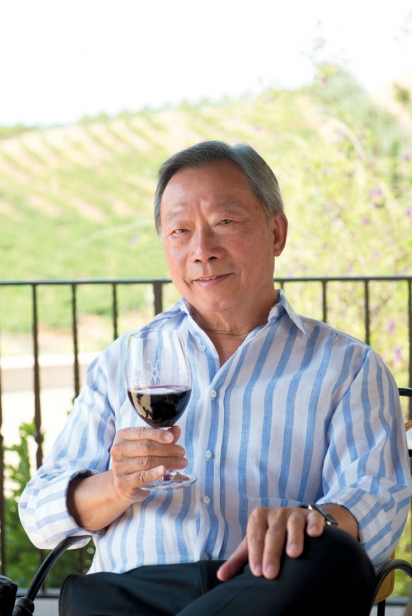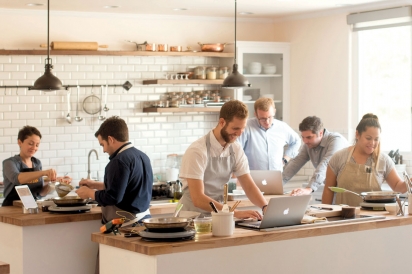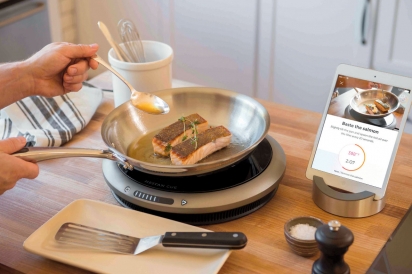Cooking’s Next Big Thing
Move Over, Self-Driving Cars: Cookware Mogul Stanley Cheng is cooking up Self-Driving Pots and Pans
Inside a secluded test kitchen on a sprawling estate on the outskirts of Napa, innovation of a most tantalizing type is brewing.
The mythic Silicon Valley garage has given way to the agrarian equivalent in a modern barn-like structure in Wine Country, where software developers are coding; a culinary assistant with a scale and a ruler is meticulously weighing and measuring 100 different-sized pork chops one by one; and a computer-controlled sauté pan atop a sleek induction burner is heating, its temperature automatically controlled to the precise degree by an app running on a tablet.
Get ready for cooking’s next big thing.
That might sound like hyperbole, but when it comes from Stanley Cheng, CEO and chair of Vallejo’s Meyer Corp., the largest cookware company in the United States and the second-largest in the world, you can’t help but believe it.
After all, this Hong Kong—born engineer turned cookware developer manufactures more than 200 lines of cookware, including the popular Circulon and Anolon lines that he invented. It’s a good bet that any given home kitchen is full of his wares since Meyer manufactures more than 42 million pots and pans annually at plants in Italy, China and Thailand. It also holds the licenses for the brands KitchenAid, Rachael Ray and Farberware.
In 1972, Cheng was the first in the world to make a flat-bottomed Chinese wok better suited to Western stovetops. In 1981, he was the first to make tempered glass lids for pots. While other cookware manufacturers may be content to roll out a new color scheme annually, Meyer brings to market revolutionary products, often more than one a year. Cheng has lost count of his many patents, but puts the number in the ballpark of 100.
“We don’t want to do simple commodity products to compete on price,” Cheng says. “Innovation is the lifeblood of this company.”
That explains why this two-story building, once his family’s home gym on their 237-acre spread, has been transformed into a hive of high culinary activity. On the drizzling December day when I visited, Team USA (Chef Mathew Peters and Commis Harrison Turone of New York’s Per Se), ensconced here while remodeling continued at the French Laundry, was going through its paces leading up to the 2017 Bocuse D’Or, which it would go on to win in January. [Team USA’s first gold medal in the 30-year old “culinary Olympics.”] As the team practiced its intricate dishes in a replica of the competition kitchen in Lyon, France, head coach Philip Tessier kept one knowing eye on them, and the other on a second kitchen steps away. Tessier is not only a former executive sous chef at the French Laundry, but also the silver medalist of the 2015 Bocuse d’Or, which marked the first time the United States had made it onto the podium in the prestigious international cooking competition. He is also director of culinary and media development for Cheng’s Hestan Smart Cooking, whose team was fervently toiling away in the second kitchen on the game-changing Hestan Cue.
Expected to launch in late spring 2017, the Cue is a fully integrated, guided, closed cooking system designed for the home cook, whether a novice or ambitious enthusiast. It consists of a sensor-embedded sauté pan, an app and a compact induction burner designed by Crucial Detail, the Chicago design studio famed for creating one-of-a-kind serving pieces for Chicago’s Alinea restaurant and for Team USA’s presentations at the Bocuse d’Or.
Just turn on the burner, then choose from 100 recipes loaded on the app. Hit “get started” to begin the how-to video, and—presto—the burner automatically starts to heat the integrated pan to the exact temperature needed, having received instructions from the thermocouple in the pan’s base by way of a control panel in the handle. When a piece of cold chicken is placed into the heated pan, thus lowering its temperature, the burner will automatically adjust itself to compensate. Want to crisp the skin for that salmon fillet recipe? The burner will automatically turn up the heat to 435° to do so, then lower itself to 375° to cook the fish through. Unlike with your typical stovetop, you don’t have to guess at what “medium-high” heat really is, or frantically fiddle with a dial to adjust the burner. It’s all done for you.
In fact, the Hestan Cue is so adept at maintaining the perfect temperature on its own that “You could pour pancake batter into that pan, leave it for two hours, and it won’t burn,” Tessier says. “You’d definitely have dried-out pancakes by then, but they would still be golden brown.”
It’s taken $15 million in research, more than two years of work and a team of about 30 people—including chefs, and engineers with experience at Amazon Kindle and Pinterest—to bring the Hestan Cue to fruition. It is expected to sell for about $550, exclusively through Hestan Cue’s online site as well as San Francisco—based retailer Williams-Sonoma.
“There are an increasing number of ‘connected cooking’ appliances coming to market, and many fail to offer any real benefit to the user,” says Bradley Kleparek, senior buyer of electrics for Williams-Sonoma.
“Hestan has created a system that seamlessly integrates communication between the burner, cookware and your smart device to enhance the cooking experience. It allows anyone to achieve perfect results—whether you’re preparing a recipe for the first time, or the hundredth time.”
Each recipe moves step by step through the ingredient list, cooking instructions and plating. Each has been tested about 20 times, not only by professional chefs, but also by Meyer employees with varying culinary skills to ensure that any cook of any ability level will be successful with it. Each also was built on an algorithm, so that depending on how thick the pork chop or how large the chicken breast, the cook times for each recipe remains accurate.
“It’s like a GPS for your kitchen,” says Tessier. “It tells you how to get from here to there with a dish. We’re not driving the car. But we give you everything you need to get you to where you need to go successfully.”
More smart pots will be added to the Cue’s line eventually, as will the ability to program the app with your own personal recipes. Cheng also anticipates that someday the Cue’s technology could even be incorporated into a full stovetop and oven. The hope is that the Cue will not only make cooking easier, but also entice more people into the kitchen.
“Every time I cook at home with a sauté pan, I still have to guess at the time and temperature—and I’m a professional cook. With the Cue, it’s a totally different experience,” Tessier says. “It’s stress-free, fun and engaging. With this, if you ask a kid if they want to use an app to cook, they’d push each other out of the way to do it.”
The Cue is not the only cutting-edge creation Cheng will launch in 2017. He also will unveil the Hestan Nanobond. Designed for the commercial kitchen, these pans have surfaces four times harder than stainless steel. They sport 1,000 nanolayers of metallic ceramic, designed to be scratch-proof, leaving their surfaces gleaming even after a hundred uses. These pans are also the first in the world, Cheng says, to feature flushed rivets. Cooks at San Francisco’s In Situ restaurant at SFMOMA have been using the pans since last summer. The kitchens at the Culinary Institute of America at Greystone and COPIA soon will be outfitted with them, too.
Cheng, who spent $20 million and six years to develop the nanobond technology, possesses a distinct advantage over most tech innovators: He doesn’t have to put on a dog-and-pony show to drum up venture capital money. Instead, his company funds it all privately, allowing him to take more chances and to bring products to market faster.
He sees his mission as a simple one: “Chefs let me know what problems they have, and I try to find solutions. I want to help improve people’s lives and food quality.”
Spend any time around the 69-year-old Cheng and you quickly realize this isn’t a man who sweats the details, but lives for them. When he dives into something, he goes head-first at full speed.
As Cheng walks around his expansive stone and stucco chateau on the property, which took eight years to complete, he points to the Steinway grand piano that’s 150 years old, the massive wood table in the foyer that once belonged to Dean Martin and the ornate crystal chandelier that once hung in the Paris apartment of Maria Callas. After investing in a gasoline-powered model airplane plant in China, he built his own airstrip here to hone his proficiency as a pilot. When he decided to start a boutique winery in 1997, he planted 95 acres of Bordeaux varietals. His first release, the 2002 Hestan Vineyards Cabernet Sauvignon, garnered 95 points from noted wine critic Robert Parker. When Cheng later found himself with a stash of old Hestan wine barrels, he had a designer stack the staves together to fashion an artsy, rippled tabletop. He’s now toying with starting a company to sell them.
Like the best of engineers, Cheng’s mind is always racing. Something will grab his attention and, just like that, he’s off and running with it. “I was intrigued by sous vide, but those plastic bags are a hassle. There has to be a better way. So I’m working on that now,” he says, trying not to reveal too much yet. “How do you steam a whole fish without undercooking it or overcooking it? It can be off by a minute and be too rare or overcooked. So I’m perfecting a way to steam so that it doesn’t overcook. It sounds impossible, but it’s not.”
Raised in Hong Kong, Cheng came to the United States to attend the University of Oregon, where he toyed with a business major before switching to engineering. Afterward, he returned to Hong Kong to take over the family aluminum manufacturing plant, Meyer, whose name is a transliteration of two Chinese words that mean “beautiful” and “Asia.”
At the time, Meyer made cheap items like flashlights and ashtrays. Cheng got the idea in 1969 to manufacture nonstick cookware after reading about DuPont’s invention of Teflon. In those early days, Teflon was typically applied onto soft aluminum, which unfortunately scratched and peeled off easily. Cheng decided to try bonding it to hard anodized aluminum, which was six times harder than regular aluminum. He also created tiny troughs on the surface so that even if the surface got scratched, the food would still release from it. In 1985, he patented his creation, and dubbed the new line of nonstick cookware Circulon. A year later, he introduced Anolon, a thick-gauged, smooth-surface, nonstick line.
“All-Clad, Calphalon and the world followed us after that,” he says.
Three years ago, he launched Hestan (the name is an amalgamation of his first name and his wife Helen’s) as the high-end branch of Meyer. It includes Hestan Smart Cooking, which was established a little over a year ago in Napa, and a commercial line of professional high-end appliances, manufactured in Anaheim, now used in the illustrious kitchens of the French Laundry, In Situ, Per Se, Alinea and Atelier Crenn.
At his age, Cheng acknowledges he should probably start to take it easy. But he hardly has. He just can’t help himself.
“Most of my friends are retired,” he says. “But I’m OK with still working. The key is to truly enjoy what you do so you don’t want to stop. To walk into a store and see my products is satisfying. To know we have made good products that are appreciated is very satisfying.”









